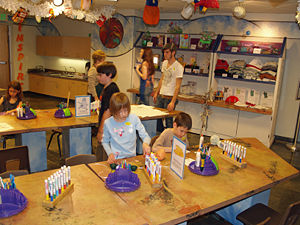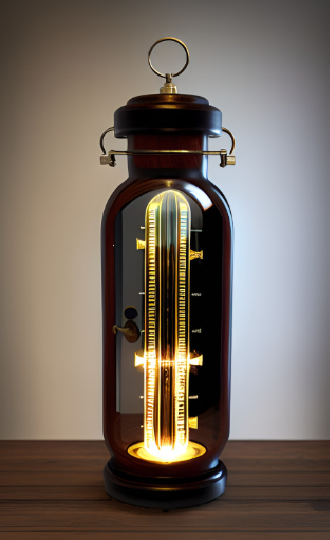- Air Homepage
- Weather Equipment
- How to Make a Barometer
How to make a barometer
Here's how to make a barometer fast and easy. If you teach science, you can show your class how the principles work. A barometer measures atmospheric pressure, which is useful for predicting weather changes.
Anyone interested in weather might want to know how to build a barometer quickly and easily. Storms and other weather events can also be predicted using one.
Creating a barometer will help illustrate the principles outlined in the second half of this article. Get a jar, some water, a metric ruler, a drinking straw, some good tape that works even when wet, and chewing gum (pick a flavor you like). Then come back here.
First, tape the ruler to the inside of the jar so you can read the numbers.
Tape your straw to the ruler, but don't cover the numbers. Make sure the straw isn't touching the bottom of the jar.
Chew your gum for a while.
In the fourth step, fill the jar half way with water.
Fifth, suck a little water into the straw, but not all the way. Halfway up is fine.
Plug the straw's top end with your gum. Put a good seal on it. It might take a little practice.
Sixth, mark where the water level is in the straw. Mark it with a permanent marker.
The seventh step is to wait and see. Water levels will fluctuate.
Higher atmospheric pressure means it's moving up. Eighth is how to calibrate a barometer:
Measure the movements in millimetres against the changes in barometric pressure.
You can get actual pressure readings from your local weather report or another barometer if you have one. Find out how many kiloPascals or hundredths of an inch of mercury each millimeter on the ruler represents.
It's best to use your barometer indoors where the temperature stays pretty constant. Temperature changes can affect pressure readings, and the fewer variables that affect a precision instrument's readings, the better your experiment will work. Check out these other barometer designs for kids if you're really curious.
Make a barometer
- using an air balloon.
How to make a barometer - with a can and a pin.
Projects like this encourage kids to think and interact with their world. The activity feeds their fascination, gives them reasons to ask questions and explore and discover themselves as well as their surroundings. Children could observe what birds visit their backyard, track their migration patterns, and research their favorite habitats. Kids can also make things that can be used for science.
Some of many people's favourite childhood memories revolve around classroom projects like this, whether they are socially-interactive and independently undertaken. Let them love their learning years. Students can learn skills like communication, problem-solving, and collaboration through classroom projects like this. They also create an environment where students can express themselves and explore their creativity.
How to make a barometer work?
Water in the straw is pushed upward by the air pressure on the surface of the water in the jar.
This is why the column goes up when the ambient pressure goes up.
When the temperature stays the same, the air air above the water inside the straw doesn't change, but the increased pressure causes it to occupy a smaller space. Everything seems to know how to make a barometer work.
Evangelista Torricelli, one of Galileo's students, wrote...We live at the bottom of an ocean of elementary air, which has weight, as incontrovertible experiments have proven. In meteorology, this has become a famous quote.
To figure out how much weight that is, barometers were developed. There are two types of traditional barometers:
Water or mercury barometers - someone figured out how to make a barometer with a vertical tube. As atmospheric pressure changes, its height changes from two to nearly three feet at ground level if it has mercury.
Does that happen a lot? Every day, but not by much. Americans and pilots usually talk about mercury pressure when they say 29 inches or something close to that.
It's usually the height the mercury column would be if it were "corrected to sea level". The pressure would be correct if the elevation were zero.
What's the deal with elevation? As you climb uphill, the air pressure drops quickly, so you can't ignore it when interpreting pressure data.
The air can't escape from an aneroid barometer because it's sealed. In a sealed container with flexible walls, the walls move inwards and outwards as the air pressure outside changes. We can measure how much they move.
How can a barometer improve aviation safety? Pilots use an aneroid barometer to figure out how high they are. This device is called an altimeter.
Barometers are great tools for predicting weather events and understanding past ones, so knowing how to make one is interesting and might be important.
Check out the Weather Equipment web page for more info. Enjoy your experiments with the barometer.
A Guide to Making a Barometer from Stuff in the Air
Make your own barometer to measure air pressure. Using everyday items, you can design a barometer. Spending a few minutes making a barometer can be a worthwhile endeavor.
Do you have concerns about air pollution in your area??
Perhaps modelling air pollution will provide the answers to your question.
That is what I do on a full-time basis. Find out if it is necessary for your project.
Have your Say...
on the StuffintheAir facebook page
Other topics listed in these guides:
The Stuff-in-the-Air Site Map
And,
Thank you to my research and writing assistants, ChatGPT and WordTune, as well as Wombo and others for the images.
GPT-4, OpenAI's large-scale language generation model (and others provided by Google and Meta), helped generate this text. As soon as draft language is generated, the author reviews, edits, and revises it to their own liking and is responsible for the content.






New! Comments
Do you like what you see here? Please let us know in the box below.